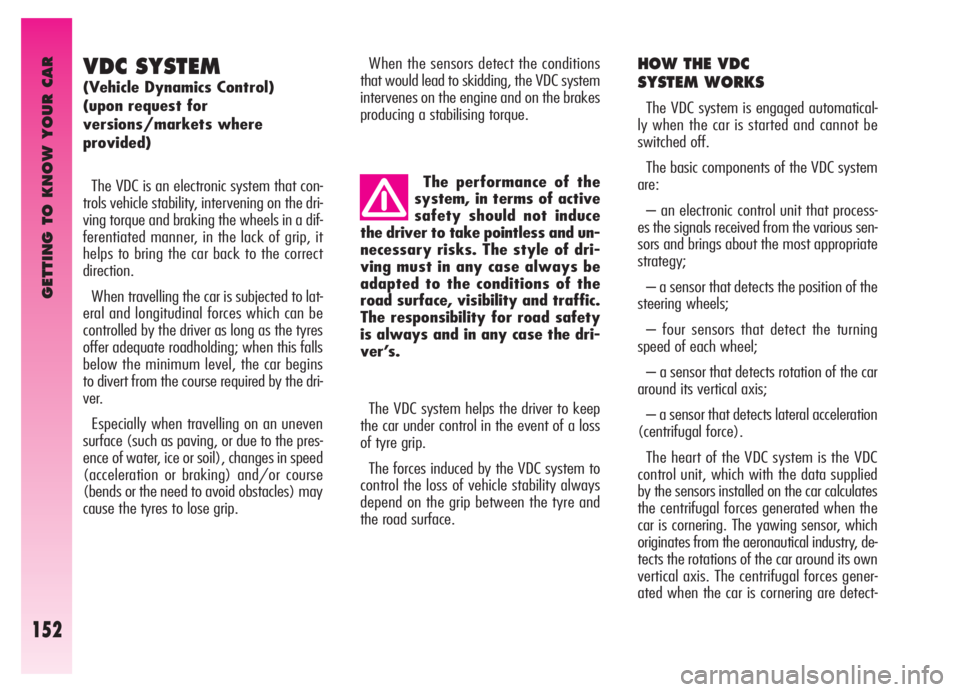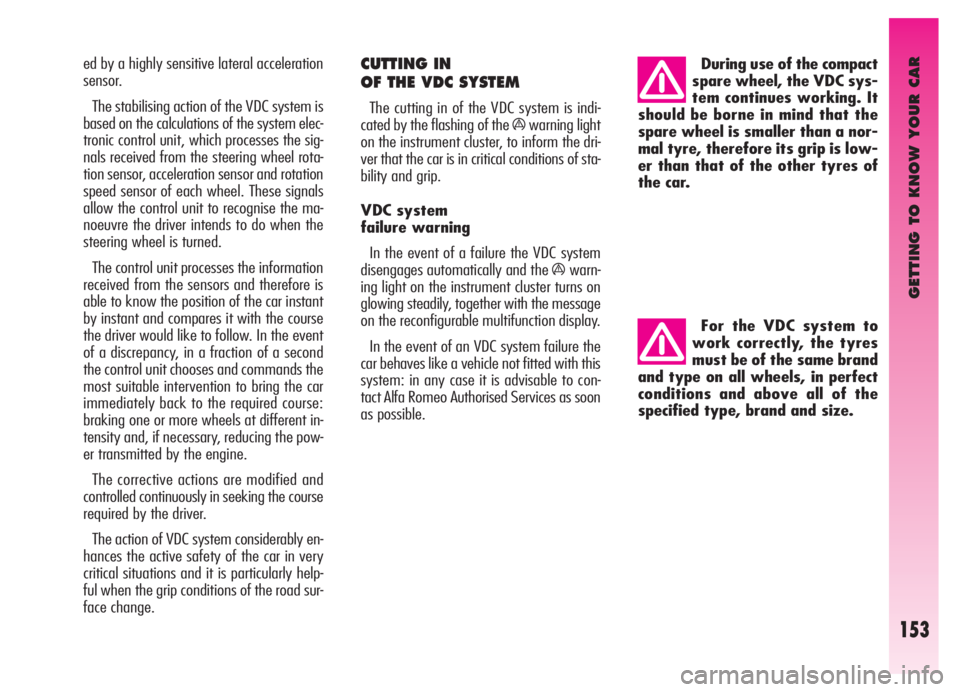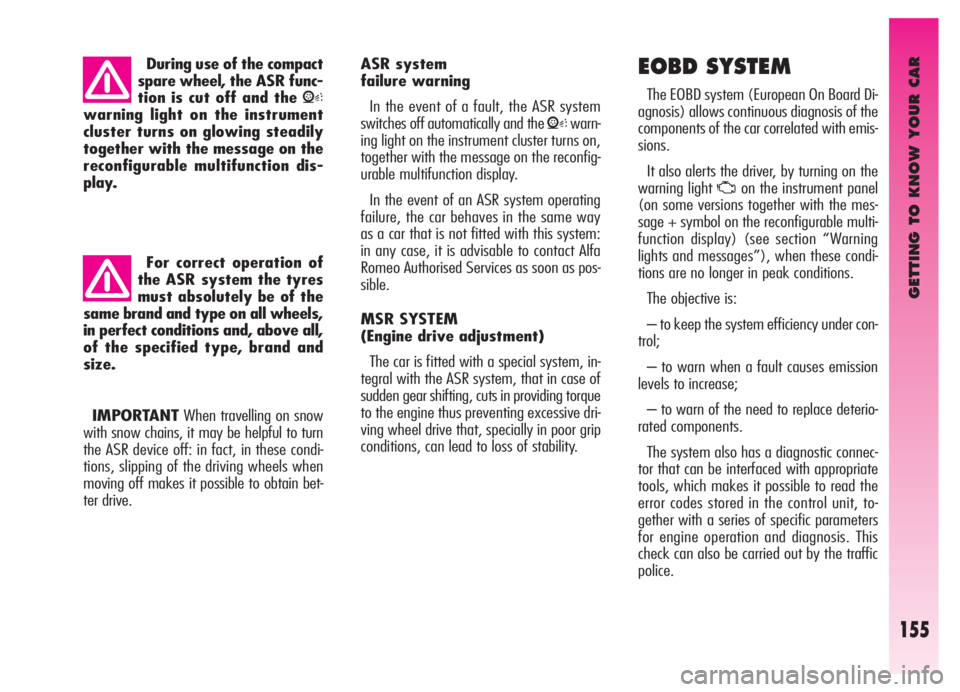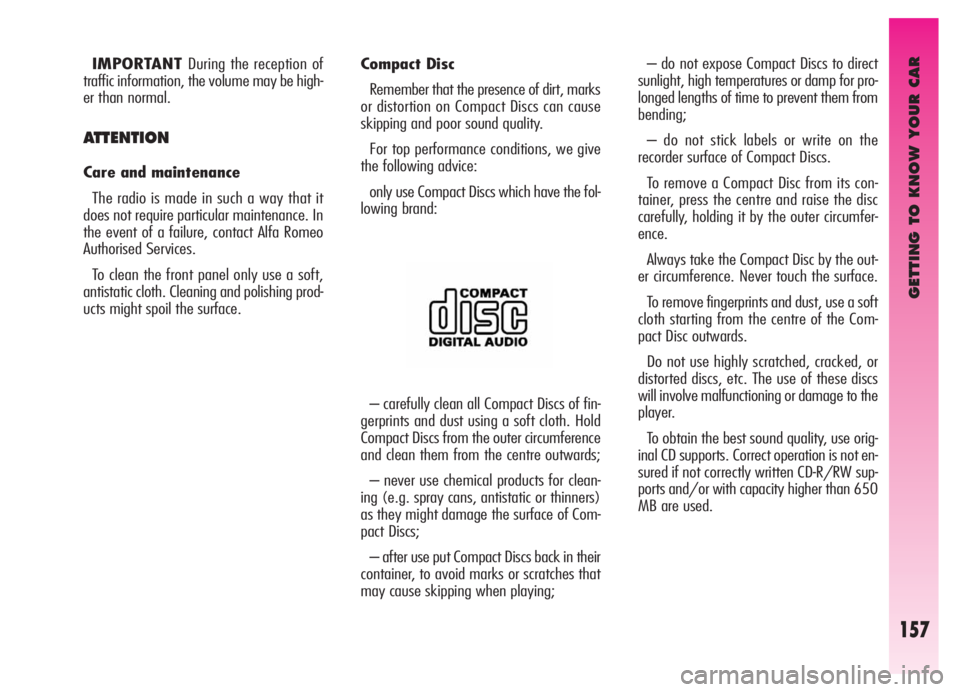Alfa Romeo GT 2005 Owner handbook (in English)
Manufacturer: ALFA ROMEO, Model Year: 2005, Model line: GT, Model: Alfa Romeo GT 2005Pages: 307, PDF Size: 6.05 MB
Page 151 of 307

GETTING TO KNOW YOUR CAR
149
Check beam aiming every
time the load carried
changes.
fig. 152
A0A0199b
For correct adjustment, bear in mind the
following conditions:
– position 0: one or two people occupy-
ing the front seats
– position 1: five people;
– position 2: five people + load in the
boot;
– position 3: driver + maximum permis-
sible load all stowed in lug-
gage compartmentHEADLIGHT ADJUSTMENT
ABROAD
(fig. 152)
The dipped-beam headlights are adjusted
for circulation in the country in which the ve-
hicle is marketed. In countries with opposite
circulation, to avoid glaring oncoming vehi-
cles it is necessary to cover the area of the
headlights as shown below; this is done us-
ing non-transparent sticker tape.
The illustration refers to passing from right-
hand drive to left-hand drive.
fig. 151
A0A00677b
IMPORTANTThe compensation for tilt of
Xenon headlights (if fitted) is carried out au-
tomatically and therefore in the versions fitted
with this type of headlights the aiming de-
vice is not present (fig. 151).
Page 152 of 307

GETTING TO KNOW YOUR CAR
150
ABS
(upon request for
versions/markets where
provided)
The car is fitted with an ABS braking sys-
tem, which prevents the wheels from lock-
ing when braking, makes full use of the grip
and within the limits of the grip available,
keeps the car controllable also in emergency
braking.
When braking a slight pulsing accompa-
nied by noise may be felt on the brake ped-
al due to the action of the ABS system.
This should not be interpreted as a brak-
ing malfunction. It is the signal to the driver
that the ABS has come into action: it is the
warning that the car is travelling at the lim-
it of its grip and therefore the speed should
be adapted to the type of road.
The ABS system is an additional part of the
base braking system; in the event of a fail-
ure it is disabled, leaving the braking sys-
tem in the same conditions as a vehicle with-
out ABS.The ABS better exploits
the grip available, but can-
not increase it; caution is
therefore necessary on slippery
surfaces, without taking unneces-
sary risks.
If the ABS cuts in it means
that the limit of the grip is
being reached between the
tyre and the road surface: it is
therefore necessary to slow down
to adapt driving to the grip avail-
able.
In the event of a system
failure, with the turning on
of the
>warning light on
the instrument cluster, have the car
checked immediately by Alfa
Romeo Authorised Services, to be
able to have the system restored
to fully efficient conditions.
In the case of a failure, the anti-lock action
is no longer present, the braking capacity of
the vehicle is not adversely affected at all.
If you have never previously used cars fit-
ted with ABS, it is advisable to practice a lit-
tle on a slippery surface, naturally in safe-
ty conditions and in accordance with the lo-
cal Highway Code; you are also advised to
read the following instructions carefully.
The advantage of the ABS over a conven-
tional system is that it makes it possible to
obtain the highest degree of handling also
when braking completely under limited grip
conditions, preventing the wheels from lock-
ing.
However, with the ABS do not expect the
braking distance to always shorten: for ex-
ample, on soft surfaces like gravel or fresh
snow or a slippery surface, the space might
increase.
To better exploit the possibilities of the an-
ti-lock system in the case of need, the ad-
vice given below should be followed.
Page 153 of 307

GETTING TO KNOW YOUR CAR
151
Always take due care when braking on
bends, even with the help of the ABS.
The most important advice of all, howev-
er, is this:
When the ABS cuts in, and
you feel the pulsing on the
pedal, do not lighten the
pressure, but keep the pedal firm-
ly pressed with no fear; this way
you will stop in the least space
possible, compatibly with the con-
ditions of the road surface.
Following these instructions you will be
in the best braking condition under all cir-
cumstances.
IMPORTANTCars fitted with ABS may
only be fitted with the wheel rims, tyres and
brake linings of type and brand approved by
the Manufacturer.
The system is completed by the EBD (Elec-
tronic Brake Distributor) which distributes
the braking action through the control unit
and the ABS system sensors.The car is fitted with an
electronic braking distribu-
tor (EBD). If the
>andx
warning lights turn on simultane-
ously with the engine running, this
indicates an EBD system failure; in
this case with sharp braking the
rear wheels might lock too early,
with the possibility of skidding.
Driving extremely carefully, go to
the nearest Alfa Romeo Authorised
Service to have the system
checked.
The turning on of only the
>warning light with the
engine running normally in-
dicates a fault to the ABS system
only. In this case the braking sys-
tem is still efficient, though with-
out the aid of the anti-lock device.
Under these conditions perfor-
mance of the EBD system may be
reduced. In this case too, you are
advised to go immediately to the
nearest Alfa Romeo Authorised
Service to have the system checked
over, driving in such a way as to
avoid sharp braking.
If the low brake fluid lev-
el
xwarning light turns
on, stop the car immedi-
ately and contact the nearest Alfa
Romeo Authorised Service. Any
loss of fluid from the hydraulic sys-
tem will negatively affect the op-
eration of the braking system be it
of the conventional type or of the
type with ABS.
If the compact spare wheel
is used, operation of the
ABS system is cut off and
the
>warning light on the instru-
ment cluster turns on.
IMPORTANTIf the battery is run down
the
>andxwarning lights might turn
on when starting the engine and go off af-
ter starting. This should not be considered
as a fault but as a warning that during start-
ing the ABS is not active. The turning off
of the warning lights ensures normal system
operation.
Page 154 of 307

GETTING TO KNOW YOUR CAR
152
VDC SYSTEM
(Vehicle Dynamics Control)
(upon request for
versions/markets where
provided)
The VDC is an electronic system that con-
trols vehicle stability, intervening on the dri-
ving torque and braking the wheels in a dif-
ferentiated manner, in the lack of grip, it
helps to bring the car back to the correct
direction.
When travelling the car is subjected to lat-
eral and longitudinal forces which can be
controlled by the driver as long as the tyres
offer adequate roadholding; when this falls
below the minimum level, the car begins
to divert from the course required by the dri-
ver.
Especially when travelling on an uneven
surface (such as paving, or due to the pres-
ence of water, ice or soil), changes in speed
(acceleration or braking) and/or course
(bends or the need to avoid obstacles) may
cause the tyres to lose grip.When the sensors detect the conditions
that would lead to skidding, the VDC system
intervenes on the engine and on the brakes
producing a stabilising torque.
HOW THE VDC
SYSTEM WORKS
The VDC system is engaged automatical-
ly when the car is started and cannot be
switched off.
The basic components of the VDC system
are:
– an electronic control unit that process-
es the signals received from the various sen-
sors and brings about the most appropriate
strategy;
– a sensor that detects the position of the
steering wheels;
– four sensors that detect the turning
speed of each wheel;
– a sensor that detects rotation of the car
around its vertical axis;
– a sensor that detects lateral acceleration
(centrifugal force).
The heart of the VDC system is the VDC
control unit, which with the data supplied
by the sensors installed on the car calculates
the centrifugal forces generated when the
car is cornering. The yawing sensor, which
originates from the aeronautical industry, de-
tects the rotations of the car around its own
vertical axis. The centrifugal forces gener-
ated when the car is cornering are detect- The performance of the
system, in terms of active
safety should not induce
the driver to take pointless and un-
necessary risks. The style of dri-
ving must in any case always be
adapted to the conditions of the
road surface, visibility and traffic.
The responsibility for road safety
is always and in any case the dri-
ver’s.
The VDC system helps the driver to keep
the car under control in the event of a loss
of tyre grip.
The forces induced by the VDC system to
control the loss of vehicle stability always
depend on the grip between the tyre and
the road surface.
Page 155 of 307

GETTING TO KNOW YOUR CAR
153
ed by a highly sensitive lateral acceleration
sensor.
The stabilising action of the VDC system is
based on the calculations of the system elec-
tronic control unit, which processes the sig-
nals received from the steering wheel rota-
tion sensor, acceleration sensor and rotation
speed sensor of each wheel. These signals
allow the control unit to recognise the ma-
noeuvre the driver intends to do when the
steering wheel is turned.
The control unit processes the information
received from the sensors and therefore is
able to know the position of the car instant
by instant and compares it with the course
the driver would like to follow. In the event
of a discrepancy, in a fraction of a second
the control unit chooses and commands the
most suitable intervention to bring the car
immediately back to the required course:
braking one or more wheels at different in-
tensity and, if necessary, reducing the pow-
er transmitted by the engine.
The corrective actions are modified and
controlled continuously in seeking the course
required by the driver.
The action of VDC system considerably en-
hances the active safety of the car in very
critical situations and it is particularly help-
ful when the grip conditions of the road sur-
face change.For the VDC system to
work correctly, the tyres
must be of the same brand
and type on all wheels, in perfect
conditions and above all of the
specified type, brand and size.CUTTING IN
OF THE VDC SYSTEM
The cutting in of the VDC system is indi-
cated by the flashing of the
áwarning light
on the instrument cluster, to inform the dri-
ver that the car is in critical conditions of sta-
bility and grip.
VDC system
failure warning
In the event of a failure the VDC system
disengages automatically and the
áwarn-
ing light on the instrument cluster turns on
glowing steadily, together with the message
on the reconfigurable multifunction display.
In the event of an VDC system failure the
car behaves like a vehicle not fitted with this
system: in any case it is advisable to con-
tact Alfa Romeo Authorised Services as soon
as possible.During use of the compact
spare wheel, the VDC sys-
tem continues working. It
should be borne in mind that the
spare wheel is smaller than a nor-
mal tyre, therefore its grip is low-
er than that of the other tyres of
the car.
Page 156 of 307

GETTING TO KNOW YOUR CAR
154
SWITCHING ON
THE ASR FUNCTION
The ASR function switches on automati-
cally each time the engine is started.
When travelling the device can be switched
off and on again pressing switch (A-
fig. 153) on the centre console.
When the device is switched off this is
shown by the lighting up of the led on the
switch itself.
If the function is switched off when trav-
elling, it will turn on again automatically the
next time the engine is started.
fig. 153
A0A0639b
ASR SYSTEM
(Antislip Regulation)
(upon request for
versions/markets where
provided)
The ASR function controls the vehicle dri-
ve and cuts in automatically every time one
or both driving wheels slip.
In slipping conditions, tow different control
systems are activated:
1) if slipping involves both driving wheels,
being caused by excessive power transmit-
ted, the ASR device cuts in reducing the pow-
er transmitted by the engine.
2) if slipping involves only one driving
wheel, the ASR system cuts in automatical-
ly braking the wheel that is slipping, with
an effect similar to that of a self-locking dif-
ferential.The performance of the
system in terms of active
safety should not induce
the driver to take pointless and un-
necessary risks. The style of dri-
ving must in any case be adapted
to the conditions of the road sur-
face, visibility and traffic. Road
surface is always the driver’s re-
sponsibility.
The action of the ASR is particularly help-
ful in the following circumstances:
– slipping of the inner wheel on a bend,
due to the effect of dynamic load changes
or excessive acceleration.
– too much power transmitted to the
wheels also in relation to the conditions of
the road surface.
– acceleration on slippery, snowy or frozen
surfaces.
– in the case of loss of grip on a wet sur-
face (aquaplaning).
Page 157 of 307

GETTING TO KNOW YOUR CAR
155
ASR system
failure warning
In the event of a fault, the ASR system
switches off automatically and the
Vwarn-
ing light on the instrument cluster turns on,
together with the message on the reconfig-
urable multifunction display.
In the event of an ASR system operating
failure, the car behaves in the same way
as a car that is not fitted with this system:
in any case, it is advisable to contact Alfa
Romeo Authorised Services as soon as pos-
sible.
MSR SYSTEM
(Engine drive adjustment)
The car is fitted with a special system, in-
tegral with the ASR system, that in case of
sudden gear shifting, cuts in providing torque
to the engine thus preventing excessive dri-
ving wheel drive that, specially in poor grip
conditions, can lead to loss of stability.
EOBD SYSTEM
The EOBD system (European On Board Di-
agnosis) allows continuous diagnosis of the
components of the car correlated with emis-
sions.
It also alerts the driver, by turning on the
warning light
Uon the instrument panel
(on some versions together with the mes-
sage + symbol on the reconfigurable multi-
function display) (see section “Warning
lights and messages”), when these condi-
tions are no longer in peak conditions.
The objective is:
– to keep the system efficiency under con-
trol;
– to warn when a fault causes emission
levels to increase;
– to warn of the need to replace deterio-
rated components.
The system also has a diagnostic connec-
tor that can be interfaced with appropriate
tools, which makes it possible to read the
error codes stored in the control unit, to-
gether with a series of specific parameters
for engine operation and diagnosis. This
check can also be carried out by the traffic
police. During use of the compact
spare wheel, the ASR func-
tion is cut off and the
V
warning light on the instrument
cluster turns on glowing steadily
together with the message on the
reconfigurable multifunction dis-
play.
For correct operation of
the ASR system the tyres
must absolutely be of the
same brand and type on all wheels,
in perfect conditions and, above all,
of the specified type, brand and
size.
IMPORTANTWhen travelling on snow
with snow chains, it may be helpful to turn
the ASR device off: in fact, in these condi-
tions, slipping of the driving wheels when
moving off makes it possible to obtain bet-
ter drive.
Page 158 of 307

GETTING TO KNOW YOUR CAR
156
IMPORTANTAfter eliminating the in-
convenience, to check the system com-
pletely, Alfa Romeo Authorised Services are
obliged to run a bench test and, if necessary,
road tests which may also call for a long jour-
ney.
INTRODUCTION
The radio is fitted with CD player (radio
with Compact Disc player) or CD MP3 play-
er (radio with Compact Disc MP3 player)
and has been designed in accordance with
the specific features of the passenger com-
partment, with a personalised design that
blends with the style of the dashboard. The
radio dimensions are suitable for the car and
as it is of fixed type it cannot be installed on
any other vehicle.
The instructions for use also include how
to control the CD Changer (if fitted) through
the radio. For the instructions for use of the
CD Changer, refer to the specific manual.
ADVICE
Too high a volume when
driving can put the drivers
life at risk and that of oth-
er people. Therefore the volume
should always be adjusted in such
a way that it is always possible to
hear the noises of the surrounding
environment (e.g. horns, ambu-
lance, police sirens, etc.).
Road safety
You are advised to learn how to use the
various radio functions (e.g. storing stations)
before starting to drive.
Reception conditions
The reception conditions change constant-
ly when travelling. Reception may be dis-
turbed by the presence of mountains, build-
ings or bridges in particular if far away from
the broadcasting transmitter. If, turning the ignition key
to MAR, the warning light
Udoes not turn on or if,
while travelling it turns on glow-
ing steadily or flashing (on some
versions together with the mes-
sage + symbol on the reconfig-
urable multifunction display), con-
tact Alfa Romeo Authorised Ser-
vices as soon as possible.
RADIO WITH COMPACT DISC PLAYER
(Upon request for versions/markets where applicable)
Page 159 of 307

GETTING TO KNOW YOUR CAR
157
Compact Disc
Remember that the presence of dirt, marks
or distortion on Compact Discs can cause
skipping and poor sound quality.
For top performance conditions, we give
the following advice:
only use Compact Discs which have the fol-
lowing brand:– do not expose Compact Discs to direct
sunlight, high temperatures or damp for pro-
longed lengths of time to prevent them from
bending;
– do not stick labels or write on the
recorder surface of Compact Discs.
To remove a Compact Disc from its con-
tainer, press the centre and raise the disc
carefully, holding it by the outer circumfer-
ence.
Always take the Compact Disc by the out-
er circumference. Never touch the surface.
To remove fingerprints and dust, use a soft
cloth starting from the centre of the Com-
pact Disc outwards.
Do not use highly scratched, cracked, or
distorted discs, etc. The use of these discs
will involve malfunctioning or damage to the
player.
To obtain the best sound quality, use orig-
inal CD supports. Correct operation is not en-
sured if not correctly written CD-R/RW sup-
ports and/or with capacity higher than 650
MB are used. IMPORTANT During the reception of
traffic information, the volume may be high-
er than normal.
ATTENTION
Care and maintenance
The radio is made in such a way that it
does not require particular maintenance. In
the event of a failure, contact Alfa Romeo
Authorised Services.
To clean the front panel only use a soft,
antistatic cloth. Cleaning and polishing prod-
ucts might spoil the surface.
– carefully clean all Compact Discs of fin-
gerprints and dust using a soft cloth. Hold
Compact Discs from the outer circumference
and clean them from the centre outwards;
– never use chemical products for clean-
ing (e.g. spray cans, antistatic or thinners)
as they might damage the surface of Com-
pact Discs;
– after use put Compact Discs back in their
container, to avoid marks or scratches that
may cause skipping when playing;
Page 160 of 307

GETTING TO KNOW YOUR CAR
158
IMPORTANTDo not use the protective
sheets for CD in commerce or discs with sta-
bilisers, etc. as they might get stuck in the
internal mechanism and damage the disc.
IMPORTANT In case CDs protected by
copy are used, it is possible to wait for a few
seconds before the system starts playing
them.
New discs may be rough around the edges.
When these discs are used, the player
might not work or the sound might skip.
To remove the roughness from the edge of
the disc use a ball-point etc.
The radio is installed in a user-friendly po-
sition for the driver and the passenger and
the graphics on the front panel make loca-
tion of the controls quick, facilitating use
use.
The CD Changer for 10 discs, if present,
is housed in the left-hand side of the boot.
Below you will find the instructions for use,
which you are advised to read through care-
fully. GENERAL
The set possesses the following functions:
Radio section
– PLL tuning with FM/MW/LW frequen-
cy bands
– RDS (Radio Data System) with TA (traf-
fic information) - PTY (Program Type) - EON
(Enhanced Other Network) - REG (Regional
Programmes) functions
– Alternative frequency search selection in
RDS mode (AF function)
– Emergency alarm reception provision
– Automatic/manual station tuning
– Manual storage of 30 stations: 18 in
the FM band (6 in FM1, 6 in FM2, 6 in
FMT), 6 in the MW band and 6 in the LW
band
– Automatic storage (Autostore function)
of 6 stations in FMT band
– SENS DX/LO function (sensitivity ad-
justing in searching radio stations)
– Scan function (scanning stored stations)
– Automatic Stereo/Mono switching.Compact Disc section
– Disc select (disc n)
– Track select (forward/backward)
– Fast forward/backward
– Repeat function (repetition of last piece)
– Scan function (scanning the tracks on
the Compact Disc)
– Mix function (random playing)
– TPM function (storing CD track playing
sequence)
– CLR function (clearing CD track storage).
For installation and con-
nection of the CD-Changer
apply only to Alfa Romeo
Authorised Services.